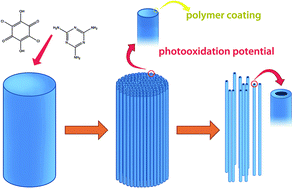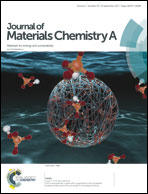Surface polycondensation as an effective tool to activate organic crystals: from “boxed” semiconductors for water oxidation to 1d carbon nanotubes†
Abstract
A series of materials are prepared by supramolecular preorganization of melamine and chloranilic acid and thermal polycondensation. Via the introduction of halogen substitution, the morphology of the supramolecular assembly was successfully altered from 2D plates to 1D nanofibers. The H-bridged crystals are organic semiconductors as such, which however can be massively activated by surface polymerization to create “boxed semiconductors” where the surface layer forms active loci for charge separation and transfer. The resulting polymer coated crystals show high photooxidation potential, as exemplified by Rhodamine B (RhB) degradation, as well as being able to liberate oxygen from water under visible light illumination. The box structure is maintained throughout further thermal condensation, and hollow 1d carbon tubes are obtained at 800 °C.



 Please wait while we load your content...
Please wait while we load your content...